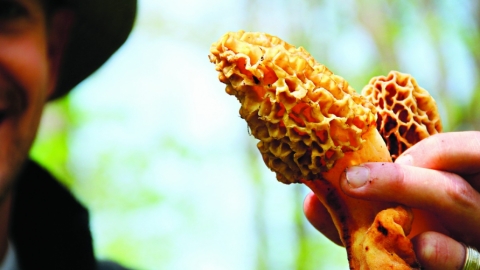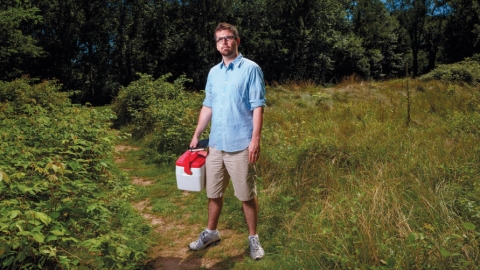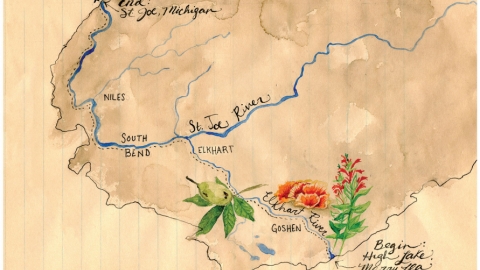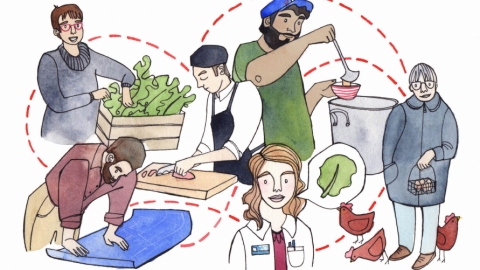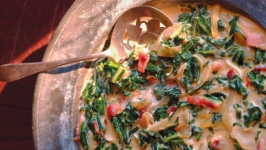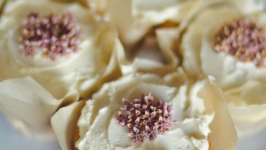Afternoon of fishing becomes a lesson on restraint during harvest
The full scent of the water hangs in the air as my 7-year-old daughter, Emmy, and I walk to the edge of the lake. We squat and dip our hands in the water to feel it—our tradition. While we watch bright-blue dragonflies dart above the lily pads, two memories come to mind.
First, how 9-month-old Emmy— as she rode in a pack on my back while I fly-fished in the mountains of Wyoming—would cackle as the trout leapt out of the water. Second, a muggy summer day bobber fishing with my gramps at a pond in Van Wert, OH.
This afternoon would be a mix of fly-fishing and bobber fishing—and something else.
While I set up Emmy’s rod, we talked about who else might have been fishing in this lake lately.
“Neighbor Larry. He likes to go fishing,” Emmy observes.
“Absolutely. What other kinds of creatures fish for food?” I ask.
“Great blue herons and belted kingfishers. Do snapping turtles?”
“Yes, and other fish like largemouth bass.”
She grins at the novelty of fish going fishing.
Pumpkinseed
With the pink fishing rod and purple reel I tried to talk her out of, Emmy casts a few feet beyond the lily pads. Plunk. She focuses on the orange tip of the painted balsawood bobber.
I select a pattern from my fly box called a Clouser minnow. It is composed mostly of a hook, thread and hair from a white-tailed deer’s tail—a deer that lived his life along the shoreline of this lake. After last fall’s bowhunt, Emmy helped me with the butchering process and we kept the tail for this purpose. She also watched me tie the fly and is excited to see if it will work.
As I am about to cast, Emmy hooks a fish and brings it in. It is a gorgeous species of sunfish called a pumpkinseed. We admire the vibrant orange and blue, and the patterns that spiral across the fish’s nose and sides.
Emmy is sure we should have this pumpkinseed for dinner, and that we should go find a salad and some dessert to make a special meal, all from the lake and woods around home. I had planned to catch a few more fish, but Emmy said the one pumpkinseed would be enough.
What Is Enough?
Maybe Emmy was more interested in going to forage for a salad than she was in fishing, and maybe she couldn’t quite picture how much food one pumpkinseed would make. Regardless, the interaction made me think about this concept of enough. With wild foods especially, we have to carefully consider our actions.
The Western tradition of taking every last bit of the harvest, if we carry this to the forest or the lake, is likely to leave ecological communities unable to bounce back. Legal limits on fish and game help, but they are not enough to protect populations. Wild plant and mushroom species have very few protections, except that people do not often know they are delicious and nutrient-dense.
Wendell Berry, a writer and environmental philosopher, writes that our humanity is expressed most beautifully through the use of restraint. The limits we have for ourselves, from his perspective, can contribute to a world where everyone has enough.
It is more feasible to practice restraint when we are dedicated to places. Here at home, I am investing in the health of future generations—human and otherwise—at the same time I am leaning on the place for dinner. One fish less may be twice the feast.
Foraging for Salad and Dessert
What would we have with this special fish? We forage along the edge of the field and woods south of home. The mosquitoes push us more into the field than along the edge, and we snack as we move along. Our salad is made of wood sorrel, red clover flowers and lamb’s-quarters, a tasty combination of sweet, pea-like and sour flavors.
Some of the mulberries are ripe by the driveway. We grab a silver tarp from the garage, spread it out underneath a lower branch and use a garden rake to knock down some fruit. We eat most of the berries but manage to save a small bowlful for later.
Preparing the Pumpkinseed
“Cut right here, behind the gill plate. Feel the knife blade ticking along the ribs?”
My dad taught me how to remove the fillets from a panfish. Now, here I am guiding my daughter’s hand. She is impressed by how much meat there is under the skin.
There are many ways to prepare pumpkinseed. They are delicious baked, grilled, curried or blackened. We choose the classic summer preparation: filleted, breaded and pan-fried. We cut the fish into strips and breaded it in egg, cornmeal and spices. Butter sizzles as we place the pumpkinseed strips in the pan.
The Summer Meal
Emmy sets the table with red plates and fills Mason jars with ice water. The process of making this special meal with my daughter, of fried pumpkinseed, foraged salad and mulberries (on ice cream), gives me something I don’t expect. While I have a new standard for what a summer meal can be, I also carry new perspective on what is enough. When a feast leaves us full of gratitude for the places, plants, animals and relationships that have come together to make it, one pumpkinseed can go a long way.





